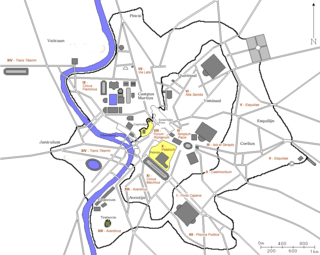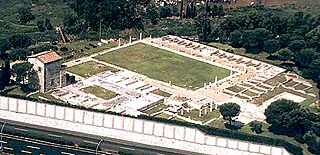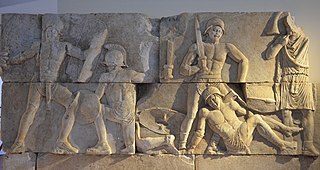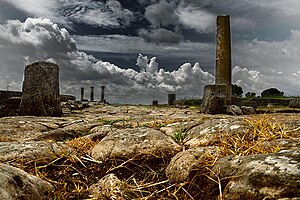
The Forma Urbis Romae or Severan Marble Plan is a massive marble map of ancient Rome, created under the emperor Septimius Severus between 203 and 211 CE. Matteo Cadario gives specific years of 205–208, noting that the map was based on property records.

In 7 BC, Augustus divided the city of Rome into 14 administrative regions. These replaced the four regiones—or "quarters"—traditionally attributed to Servius Tullius, sixth king of Rome. They were further divided into official neighborhoods.

Capena is a town and comune in the Metropolitan City of Rome, Lazio region. The town has borrowed its modern name from a pre-Roman and Roman settlement that was 3 kilometres (1.9 mi) to its north.

Lucus Feroniae was an ancient sanctuary or, literally sacred grove ("lucus"), dedicated to the Sabine goddess Feronia, protector of freedmen, ex-slaves. It was located near to the ancient town of Feronia in Etruria on the ancient Via Tiberina, in what is now the territory of the modern commune of Capena, Lazio.

The Cremera is a 36.7-kilometre (22.8 mi) Italian stream in Lazio which runs past Sacrofano, Formello, and Campagnano di Roma before falling into the Tiber about 10 kilometres (6 mi) north of Rome. It connects to the Tiber just as the Via Flaminia intersects the Grande Raccordo Anulare highway, on the proximity of the Labaro Roma Nord railway station, where there is an ancient Roman bridge. The identification with the Fosso della Valchetta is fixed as correct by the account in Livy ii. 49, which shows that the Saxa Rubra were not far off, and this we know to be the Roman name of the post station of Prima Porta, about 12 kilometres (7 mi) from Rome on the Via Flaminia. It is famous for the defeat of the three hundred Fabii, who had established a fortified post on its banks.

Lucos Cozza was an Italian Roman archaeologist.

Pietro Rosa was an Italian architect and topographer. He studied the settlements of the ancient Roman countryside and carried out a systematic series of excavations on the Palatine Hill in Rome.

Fiano Romano is a town and comune (municipality) in the Metropolitan City of Rome, Italy, approximately 40 kilometres (25 mi) north of the city.

Prima Porta is the 58th zona of Rome, identified by the initials Z. LVIII. The name Prima Porta came from an arch of the aqueduct that brought water to the Villa of Livia, which formed over Via Flaminia a sort of gateway which travellers saw as the first indication of having reached Rome (Piperno).

Feronia or Lucus Feroniae was an ancient roman municipium border the present Via Tiberina and Autostrada A1, current Comune of Capena near the present town of Fiano Romano. It is located in the plain along the Tiber Valley, at the foot of Mount Soracte, and was within the ancient territory of Capena. It began as a sanctuary called Lucus Feroniae in the time of Tullus Hostilius when it was located in Etruria.

The Villa of Livia is an ancient Roman villa at Prima Porta, 12 kilometres (7.5 mi) north of Rome, Italy, along the Via Flaminia. It may have been part of Livia Drusilla's dowry that she brought when she married Octavian, her second husband, in 39 BC. However, it may also have been a gift given to her by Octavian upon their betrothal. The ancient sources tell us that Livia returned to this villa following the marriage. It was her sumptuous country residence complementing her house on the Palatine Hill in Rome.

Baths of Constantine was a public bathing complex built on Rome's Quirinal Hill, beside the Tiber River, by Constantine I, probably before 315.
The temple of Minerva Medica was a temple in ancient Rome, built on the Esquiline Hill in the Republican era, though no remains of it have been found. Since the 17th century, it has been wrongly identified with the ruins of a nymphaeum on a nearby site, on account of the erroneous impression that the Athena Giustiniani had been found in its ruins.
The Murus Terreus Carinarum is an obscure earthwork fortification of the ancient city of Rome known from a passage in the works of Varro. The Murus Terreus may have been a part of Rome's earliest fortifications, often referred to as the Servian Wall. While the location of the Murus Terreus remains unknown and debated, it is thought likely that it belonged to the fortifications of the Oppian Hill, thus placing it between the Carinae and the Subura. Pinza suggested that the works were located on the summit of the Oppian.

Alda Levi Spinazzola was an Italian archaeologist and art historian.

Crepereia Tryphaena was a young Roman woman, presumably about 20 years old, whose sarcophagus was found during the excavation works started in 1889 for the foundations of the Palace of Justice and for the construction of the Umberto I bridge over the Tiber in Rome. Among the items found in her sarcophagus were pieces of a funeral outfit, including a sculpted doll.

The ancient Roman Villa dei Volusii or Villa dei Volusii-Saturnini is an archaeological site located in the municipality of Fiano Romano, next to the ancient Roman town and sanctuary of Lucus Feroniae, along the route of ancient Via Tiberina.

The Mausoleum of Fiano Romano is a set of thirteen large blocks of Carrara marble decorated in relief of the 1st century BC, approximately 0.60 metres (2.0 ft) x 1.00 metre (3.28 ft) x 0.30 metres (0.98 ft), with scenes of Gladiator fights that originally decorated three sides of an imposing funerary monument tower.

The Bust of Augustus with Gemmed Crown is a Roman Bust depicting the first emperor of the Roman Empire, Augustus.

The archaeological area of Poggio Sommavilla is an archaeological site located in Poggio Sommavilla, a Frazione of the Comune of Collevecchio in the Tiber valley.


















